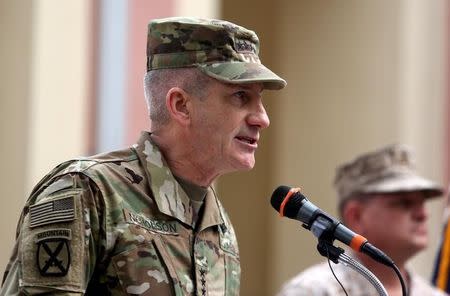Giant prison for Afghan militants aims to avoid pitfalls of past

By Paul Tait PARWAN, Afghanistan (Reuters) - A sprawling U.S.-built complex in Parwan province, northwest of Kabul, acts as jail, hospital and courtroom for thousands of combatants captured on battlefields across Afghanistan. Now run by Afghan security forces, the facility is touted by U.S. commanders as a potential model for counter-terrorism operations in Afghanistan and beyond. To do so, it will have to avoid past prisoner abuse scandals that have damaged the reputation of the U.S. military and its allies, including in Afghanistan and Iraq. "It will be an essential part of a future counter-terrorism platform in Afghanistan," General John Nicholson, the new commander of U.S. and NATO forces in Afghanistan, told Reuters on a visit to the Parwan facility. Reflecting the intensifying battle between Afghan security forces and Taliban militants, the National Security and Justice Centre has seen the number of prisoners rise from 700 at the end of 2014 to 4,400 inmates now. The facility has a maximum capacity of 5,900. The centre was transferred to Afghan authority at the end of 2014, when U.S. and NATO forces ended their combat operations in Afghanistan and their mission was refocused to training and assisting Afghan forces and counter-terrorism. Many captives taken by Afghan forces are now transferred to Parwan instead of being held at regional jails, said U.S. military officials accompanying Nicholson, including chief spokesman Brigadier General Charles Cleveland. They receive medical treatment if required, undergo security checks and are charged. They remain detained while their cases are investigated by prosecutors and, if warranted, are tried before judges in the justice centre. "RULE OF LAW" U.S. officials at the jail confirmed "some" foreign fighters were being held there, but gave no further details. U.S. troops have been accused of abusing prisoners in the old military prison in Bagram, not far from the Parwan centre. The officials said safeguards protecting the rights of detainees had been put in place. "We have to have the rule of law, so that when we capture these terrorists on the battlefield they have to be delivered to the judicial system," Nicholson said. The new facility does have its problems, however. Nicholson was told during a meeting with Afghan officials that a lack of fuel had become a significant issue. "Some of this is due to incompetence, but some of it is due to corruption," Nicholson told the officials, who included the commander of the facility, Lieutenant General Mir Saheb Gul. "We will look into this, because we buy enough fuel that you should not have to worry about it," he said. Security at the facility, provided by police and Afghan soldiers, is an obvious concern. Recent militant attacks on urban centres, including in the northern city of Kunduz which the Taliban briefly captured last year, have begun with an assault on the local jail. U.S. officials travelling with Nicholson said centralising different functions in one location would hopefully prevent mass jail breaks that have embarrassed Afghan authorities and their NATO allies in the past. Most famously, 488 inmates escaped jail in southern Kandahar province in April 2011 through a 320-metre tunnel dug by the Taliban from a nearby house into the main jail. Officials travelling with Nicholson described the Parwan facility as "tunnel-proof". (Additional reporting by James Mackenzie; Editing by Mike Collett-White)

